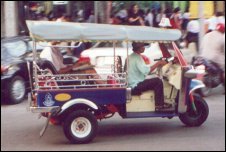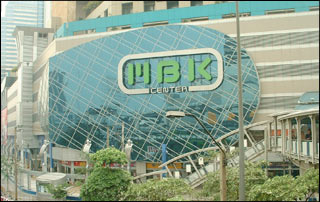
Officially opened on the 28th September 2006 to replace the aging Don Muang airport, Bangkok's new Suvarnabhumi international airport is actually in the nearby Samut Prakan province about 25km to the east of Bangkok. Suvarnabhumi was named by King Bhumibol Adulyadej and means "the golden land" in Thai, although it's English spelling is certain to lead to mispronunciations by visitors as it's actually pronounced like 'su-wan-na-poom'. Though Don Muang airport had three terminals, Suvarnabhumi has only one (very large) one that handles all international and domestic flights. At a size of 563,000sq m, Suvarnabhumi's terminal building is the second largest in the world.
Over 40 years in construction and eventually opened shortly Thailand's 2006 coup that removed Thaksin Shinawatra from power, Suvarnabhumi has had a controversial history of extensive delays, corruption allegations, political meddling, media reports of flawed construction and massive budget overruns - and that was all before the airport even opened.
The final bill for Suvarnabhumi stands at over US$3 billion and while it's undoubtedly a very impressive and modern structure, the Thai newpapers report new problems with the airport with embarrassing regularity. Issues range from the most serious of cracks on the runway and other construction problems to complaints from passengers of poor signage, long queues and inadequate facilities. In the initial period after opening these problems were compounded by up to 100,000 Thais coming to visit and picnic in the airport each day and putting strain on the airports facilities, but with waning public interest this is thankfully no longer a problem.
The root cause of the problems appears to be a rush to open the airport before it was really ready, and several senior Airports Authority of Thailand officials have been removed from their posts as a result of the mess. Latest (February 2007) reports are that Don Muang airport is to be re-opened for both international and domestic flights, to relieve some of the pressure from Suvarnabhumi and to allow the much needed repairs to take place. How this will work in practice is unclear at this point, but it could well mean passengers needing to travel between the two airports (a one hour or longer journey) in order to board a connecting flight. If you think this could affect you, you're well advised to check with your airline as soon as possible for the latest news.
If you've previously used Bangkok's Don Muang airport, note that it's no longer necessary to pay the 500 baht per person Passenger Service Charge at Suvarnabhumi. From February 2007, the charge was increased to 700B but it's now included in the price of your ticket. The departure tax for domestic flights is 60B, collected at check in.
Suvarnabhumi is organised into 4 separate levels:
Level one is the bus and taxi lobby where you can go to get downtown.
Level two is the arrivals area.
Level three is the "Meeting Center" level, where the majority of Suvarnabhumi's facilities are.
Level four is departures.
In addition, there's the separate Public Transportation Center (PTC) building which is about 10 minutes from Suvarnabhumi terminal. Free shuttle buses regularly ply the route back and forth between them leading from level one. If you want to get a public bus downtown or to a destination other than Bangkok, you need to head to the PTC first while if you're getting a taxi you can get one either from the terminal building itself or the PTC. More details are on the
taxi and
other ways downtown pages.
ATMs (with Cirrus/Maestro, Visa, Mastercard, Plus and others) and currency exchange are available at the airport 24 hours a day. The exchange rates available at the airport are generally not that much worse than in the city itself, and so you you won't lose out too much by changing money here. Internet access is available, but at a cost of 500B an hour it's up to 20 times (!) the price of internet cafes in Bangkok itself.
Other facilities at the airport include bars, restaurants (mostly fast food with Pizza Hut, KFC, Burger King etc... but there's a good and cheap Thai foodcourt on the walkway between the International and domestic terminals), a couple of decent 24 hour bars, duty free and normal shops, a small branch of the
Tourism Authority of Thailand,
Thai Hotels Association, and car hire. Trolleys are available but can't be taken past immigration. The THA can get you better rates at mid-range and expensive hotels than you would get as a walk-in, but you still pay more than the going rate. Make sure you have some idea about where you want to stay and what kind of prices you should be paying for it. Different hotels pay them different rates of commission so don't be surprised if they suggest other hotels to one you decided on - they aren't impartial by any means.
The airport has one attached hotel, the 4 star Novotel Suvarnabhumi Airport Hotel which is only 5 minutes away via an underground walkway. It has all the facilities you'd expect and rates start at around $90 a night.
Getting downtown is cheap and not too much of a problem, and there's no lack of options either: Taxis, airport buses, normal buses, limousines, boats, the train and even a helicopter are all available. When you book hotels in Thailand, your travel agent will likely offer airport transfers as an extra which may well be very overpriced - don't bother if it costs any more than US$15 or so (in total, not per person).
When leaving it is also possible to claim back VAT on certain goods you have bought in Thailand - the forms for this can be got at shops displaying "Vat Refund for Tourists" signs in the city. Take the forms, the goods themselves and your passport to the tax refund counter (which is in the departure hall), pay the 100B service fee, and you will be given the refund. Note they require to see the goods bought, which can be very inconvenient if they are packed away in your baggage. You must have spent a minimum of 5000B, and 2000B in each transaction, to qualify for this. It's a bit of a cumbersome procedure overall, which discourages many from taking advantage of it.










